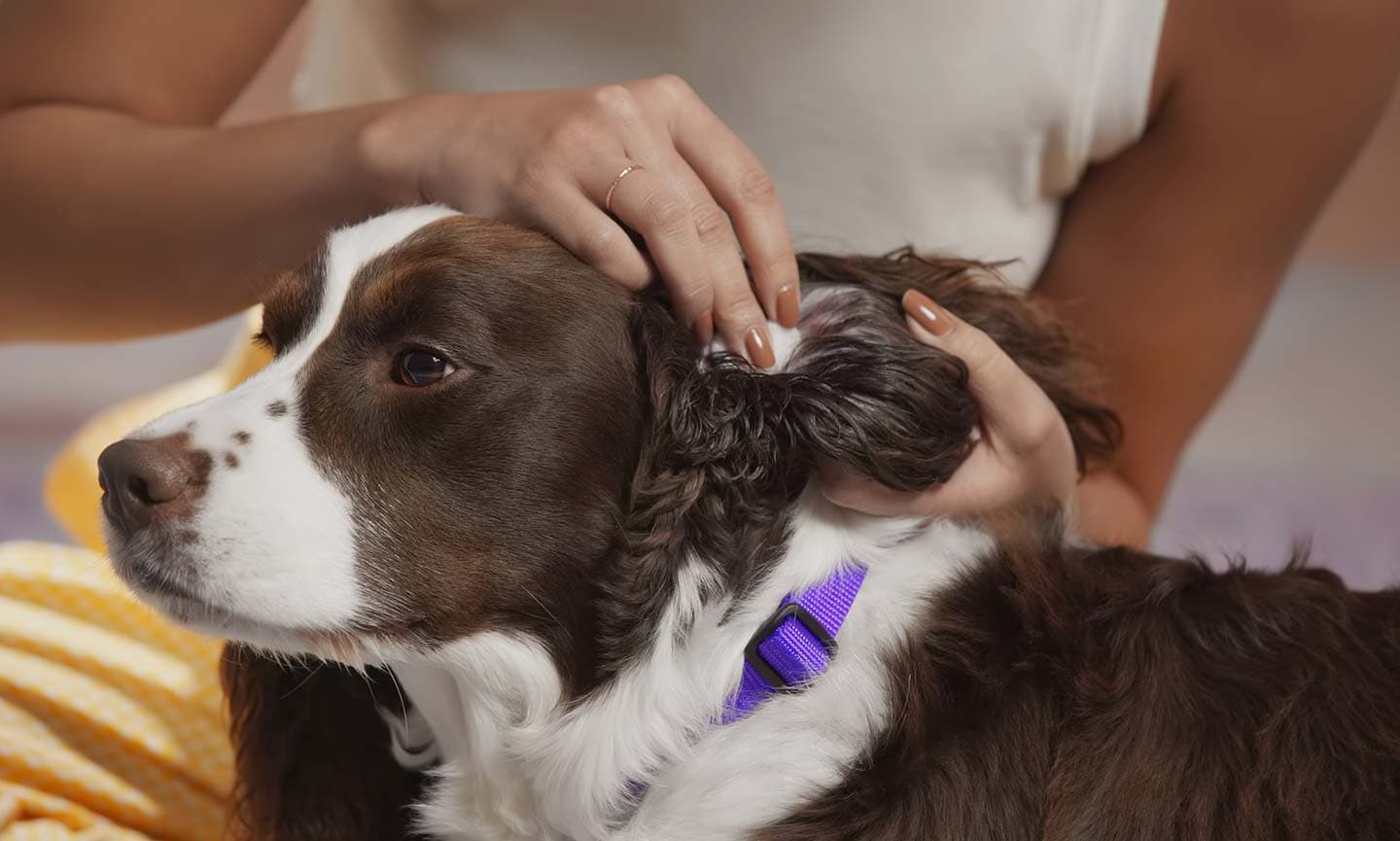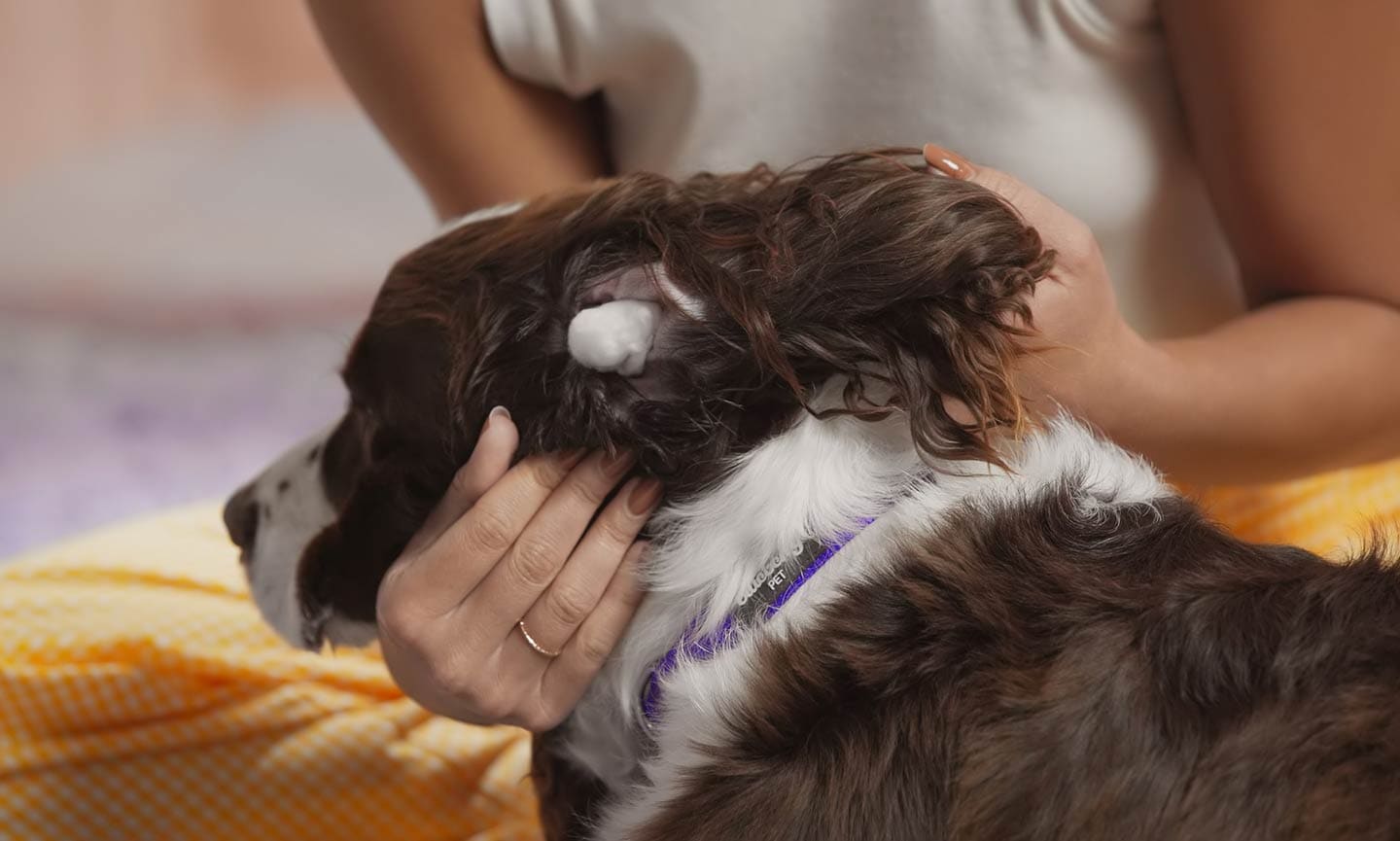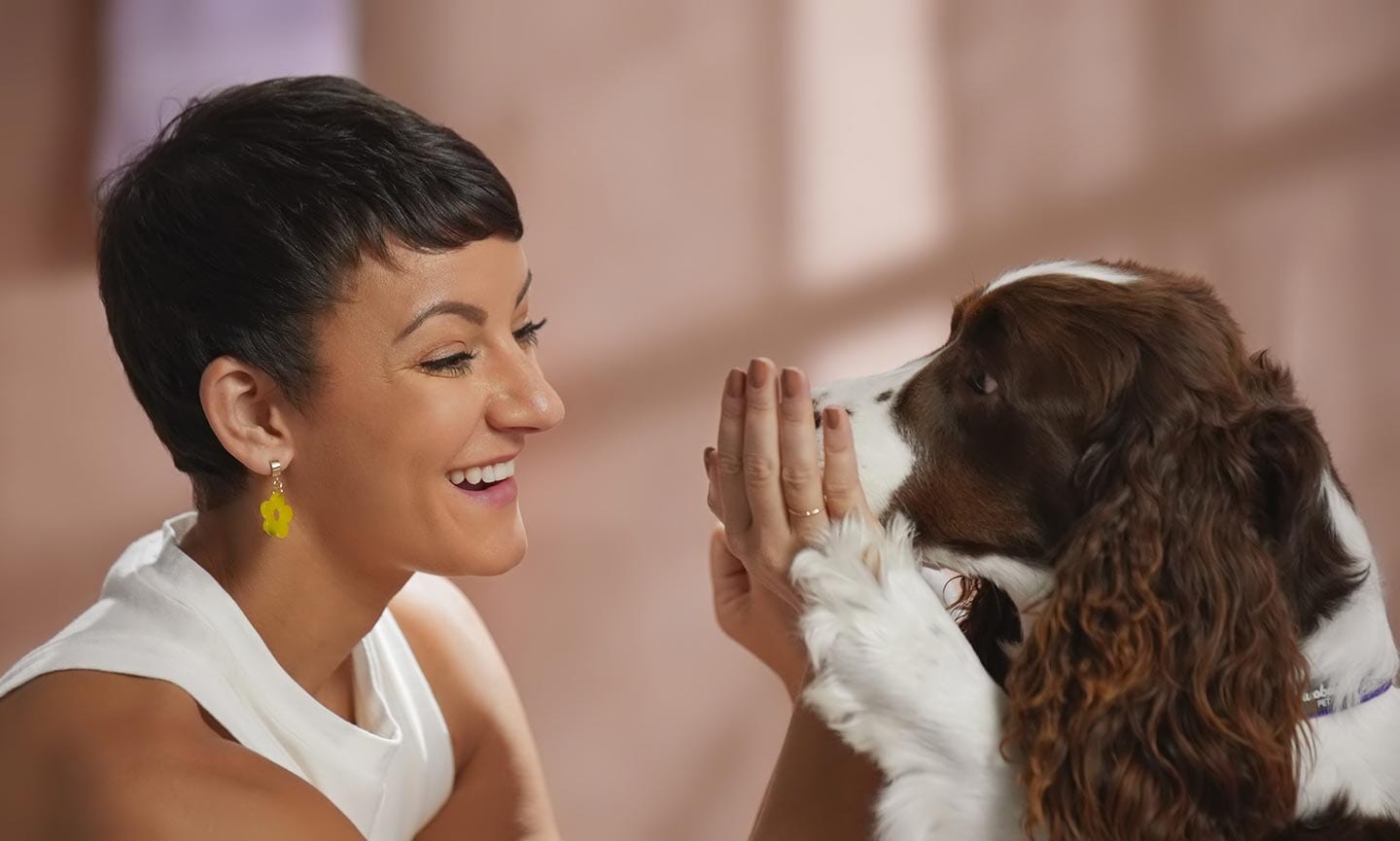Believe it or not, earwax does some pretty amazing things for your dog, like trapping dirt and debris. But too much wax can cause blockages and prevent the ear from ejecting the gunk that can lead to infections—not to mention that, well, it’s pretty gross. Keeping dog ears clean can go a long way to preventing needless pain and suffering, but doing it incorrectly can create more problems. So how do you clean a dog’s ears?
The first step? Talk to your veterinarian. While some dogs’ ears need regular cleaning, not all dogs need to have their ears cleaned on a regular basis—and washing your dog’s ears too often can actually cause infections and other health issues. Your vet can tell you how often your furry friend needs an ear cleaning, and recommend any special products or tools that may help them.
For more advice on how to clean dog ears, we talked to the experts: Dr. Ashley Barnes, medical director at Louisville Family Animal Hospital in Louisville, Colorado; Daryl Conner, master pet stylist and owner of FairWinds Grooming Studio in Appleton, Maine; Dr. Zenithson Ng, a clinical associate professor in the Department of Small Animal Clinical Sciences at the The University of Tennessee College of Veterinary Medicine in Knoxville; and Dr. Kristan Slotterback, an associate veterinarian with Cherry Hill Animal Hospital in Cherry Hill, New Jersey. Armed with their best tips on how to clean dog ears effectively and safely, how to check for signs of build-up and infection, and which supplies to have handy, plus the advice of your vet, you'll be fully prepared to clean your dog's ears.
Signs That It’s Time to Clean Your Dog’s Ears
Before you learn how to clean dog ears, it’s important to understand when you should clean them—and just as importantly, when it’s best to seek your vet’s advice instead. If your dog’s ears are infected or inflamed, cleaning them can make the problem worse. Contact your veterinarian for a proper diagnosis and treatment if you notice any of the following signs of infection:
- Redness in the ear canal
- Swelling
- Foul odor
- Excessive dark brown, yellow-green and/or bloody discharge
- Scratching the ears or face
- Pain on contact
- Head shaking, possibly leading to dog ear hematomas
Monitor your dog’s ears weekly for signs of infection or inflammation, so you can catch any problems early on.
So when should you clean your dog’s ears? Look for these signs that indicate your dog’s ears need a wash:
- Head shaking
- Scratching at the ears
- Odor coming from the ear(s)
- Visible residue in the ear(s)
If you notice one or more of these four signs, and you’re sure your dog’s ears aren’t infected or inflamed, chances are it’s time to clean.
How Often Should You Clean a Dog’s Ears?
The answer to this question is different for every dog, ranging from weekly cleanings to every two months or even longer. That’s why it’s important to ask your vet about which routine is right for your pup.
A big determining factor is your dog’s breed. Certain dog breeds, such as Cocker Spaniels, have large, floppy ears that can trap moisture or debris inside, putting them at higher risk for irritation and infection. Other breeds are prone to excessive hair in their ear canals, increased ear wax production, underlying allergic disease and/or very narrow ear canals—all of which can require more frequent cleanings. Dogs without any of these issues can usually get by with a cleaning every one to two months.
Some pups may not even need to have their ears cleaned at all. In fact, if the dog’s ear is clean and healthy, introducing cleaner into the canal could actually cause problems. Dog ears are a tiny ecosystem, and if all is well, experts agree to leave well enough alone. Hey, if it ain’t broke, don’t fix it!
What You’ll Need to Clean Your Dog’s Ears
To keep dog ears clean, you’ll need to have a few supplies ready before you start.
1 Dog Ear Cleaning Solution
Opt for a veterinary-recommended cleaner. Do not use household products like vinegar or hydrogen peroxide, which can irritate the ear.
The dog ear cleaning solution you choose should also have a drying component. Products without drying agents can predispose some dogs to ear infections, especially if used frequently or after bathing or swimming. Look for ingredients like isopropyl alcohol, acetic acid, malic acid, salicylic acid and boric acid on your cleaner’s label. MalAcetic Otic and OtiRinse Ear Cleansing/Drying Solution are both veterinarian-recommended cleaners with drying agents.
For dogs with sensitive skin, you may want to opt for a cleaner with ingredients like propylene glycol, lanolin, glycerin, lactic acid or parachlorometaxylenol, such as Douxo Micellar Dog & Cat Solution. These cleaners are drying, but more gentle on your pup’s ears.
2 Cotton Gauze, Cotton Balls or Squares
You probably already know that it’s unsafe to stick cotton swabs into your own ears. That rule applies to dog ears, too. Cotton-tipped applicators should never be inserted into a dog's ear canal. You could perforate the ear drum, introduce foreign material and/or cause an ear infection by doing so.
Instead, have cotton balls or squares handy. You can use them for cleaning the outer part of the ear, wiping up any excess cleaning solution, and for helping to moderate the flow of cleaning solution during your cleaning. (See our step-by-step guide below for how to use them.)
3 High-Value Treats
A special treat offered before, during or after a cleaning session can help make the experience a positive one—both for your pup and for you. A lick mat (we recommend Aquapaw’s Slow Treater lick mat) spread with peanut butter, canned food or canned cheese can help keep dogs occupied during the entire cleaning process, making them especially great if you’re cleaning your dog’s ears single-handedly!
4 Dog Ear Wipes or Pads (Optional)
These products help clean debris from the parts of the ear you can see and touch (aka not the ear canal), with the added benefits of being convenient and relatively mess-free. Another plus is that they’re formulated to be gentle on ears. Pet MD Aloe Vera & Eucalyptus Dog Ear Wipes, for example, contain soothing and healing aloe.
How to Clean Your Dog’s Ears: Step-by-Step Instructions
When you’re preparing to clean your dog’s ears, aim for a time when your dog is calm and relaxed and when you have plenty of time to commit to washing your dog’s ears. Remember: Starting slow is the key to easier cleanings throughout your dog’s life. Ear cleanings should not be forced, because that can make your dog fearful of future cleanings. Instead, work through the steps below, offering plenty of treats and praise along the way, and perform only the steps your dog will tolerate. If necessary, you can work up to a full cleaning over time. The key is to keep the experience as positive as possible.

1 Place a cotton ball or piece of gauze in the outer ear canal

Start by inserting a piece of cotton (either a cotton ball or cotton gauze) just slightly into the opening of your dog’s ear. One cotton ball works for most medium and large breeds; about half a cotton ball works best for smaller dogs.
Avoid pressing the cotton too far inside your dog’s ear, which can present the same risks as inserting a cotton swab. The cotton should go no further than just inside the opening to the ear canal, so that it stays in place without you holding it there, but is easy for you to remove (or for your dog to shake out) when the cleaning is over.
Why insert cotton first? When it’s time to use the ear cleaner, the cotton moderates the flow of the liquid into your dog’s ear canal, making it a more comfortable experience for your pup.

2 Fill the ear canal with cleaning solution.
Place the tip of the cleaning container on top of the gauze, right next to the opening of the ear canal. Again, do not press the cotton or gauze far inside the ear. Allow the cleaning solution to saturate the cotton and flow into the ear canal. You may hear a crackling or squishing sound as the cleaning solution works to remove the wax. Remember to keep the treats coming!
When the ear is full, the gauze or cotton will be saturated with the fluid, and the ear canal will sound squishy when you massage it (more on that below.)
Be sure to clean the tip of the ear cleaning solution container thoroughly after every use. Otherwise, bacteria, yeast and other debris can accumulate on the tip and introduce infections the next time you clean—which pretty much defeats the whole purpose of cleaning!

3 Massage the ear canal.

4 Let your dog shake their head.

5 Wipe away the remaining debris.

6Offer your dog a yummy treat for a job well done.
End the session with lots of praise and a treat your dog especially loves, to let them know this whole ear cleaning business is a good thing. Besides, they deserve it!
If ear debris is still present after you clean your dog’s ears, you can try cleaning again—but only if your dog is up for it. Don’t repeat the cleaning if your pup appears to be in pain. Instead, contact your veterinarian to ensure there is not another issue such as an infection or a foreign body or mass in the ear. Your vet may also be able to give you advice on ear cleaning techniques that may be more effective for your individual dog.
Now that you know how to clean your dog’s ears, you can help prevent infections, pain and discomfort caused by wax build-up. Just remember: Before starting any ear cleaning regimen, check with your veterinarian about how often to clean and what products to use. Happy cleaning!
Expert advice provided by: Dr. Ashley Barnes, medical director at Louisville Family Animal Hospital in Louisville, Colorado; Daryl Conner, master pet stylist and owner of FairWinds Grooming Studio in Appleton, Maine; Dr. Zenithson Ng, a clinical associate professor in the Department of Small Animal Clinical Sciences at the The University of Tennessee College of Veterinary Medicine in Knoxville; and Dr. Kristan Slotterback, an associate veterinarian with Cherry Hill Animal Hospital in Cherry Hill, New Jersey.
This content was medically reviewed by a veterinarian.
Share:













